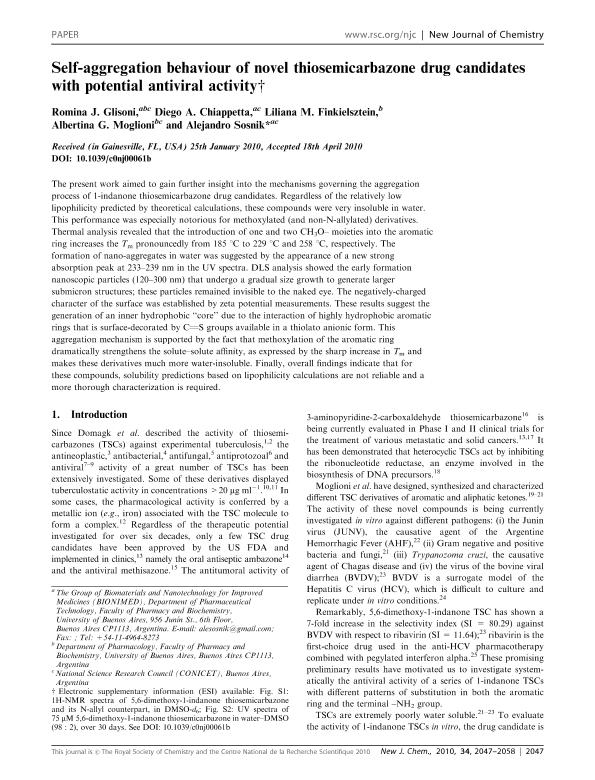Artículo
Self-aggregation behaviour of novel thiosemicarbazone drug candidates with potential antiviral activity
Glisoni, Romina Julieta ; Chiappetta, Diego Andrés
; Chiappetta, Diego Andrés ; Finkielsztein, Liliana Mónica; Moglioni, Albertina Gladys
; Finkielsztein, Liliana Mónica; Moglioni, Albertina Gladys ; Sosnik, Alejandro Dario
; Sosnik, Alejandro Dario
 ; Chiappetta, Diego Andrés
; Chiappetta, Diego Andrés ; Finkielsztein, Liliana Mónica; Moglioni, Albertina Gladys
; Finkielsztein, Liliana Mónica; Moglioni, Albertina Gladys ; Sosnik, Alejandro Dario
; Sosnik, Alejandro Dario
Fecha de publicación:
06/2010
Editorial:
Royal Society of Chemistry
Revista:
New Journal of Chemistry
ISSN:
1144-0546
Idioma:
Inglés
Tipo de recurso:
Artículo publicado
Clasificación temática:
Resumen
The present work aimed to gain further insight into the mechanisms governing the aggregation process of 1-indanone thiosemicarbazone drug candidates. Regardless of the relatively low lipophilicity predicted by theoretical calculations, these compounds were very insoluble in water. This performance was especially notorious for methoxylated (and non-N-allylated) derivatives. Thermal analysis revealed that the introduction of one and two CH3O- moieties into the aromatic ring increases the Tm pronouncedly from 185 °C to 229°C and 258 °C, respectively. The formation of nano-aggregates in water was suggested by the appearance of a new strong absorption peak at 233-239 nm in the UV spectra. DLS analysis showed the early formation nanoscopic particles (120-300 nm) that undergo a gradual size growth to generate larger submicron structures; these particles remained invisible to the naked eye. The negatively-charged character of the surface was established by zeta potential measurements. These results suggest the generation of an inner hydrophobic "core" due to the interaction of highly hydrophobic aromatic rings that is surface-decorated by CS groups available in a thiolato anionic form. This aggregation mechanism is supported by the fact that methoxylation of the aromatic ring dramatically strengthens the solute-solute affinity, as expressed by the sharp increase in Tm and makes these derivatives much more water-insoluble. Finally, overall findings indicate that for these compounds, solubility predictions based on lipophilicity calculations are not reliable and a more thorough characterization is required.
Palabras clave:
SELF-AGGREGATION
,
THIOSEMICARBAZONE
,
ANTIVIRAL ACTIVITY
Archivos asociados
Licencia
Identificadores
Colecciones
Articulos(OCA HOUSSAY)
Articulos de OFICINA DE COORDINACION ADMINISTRATIVA HOUSSAY
Articulos de OFICINA DE COORDINACION ADMINISTRATIVA HOUSSAY
Citación
Glisoni, Romina Julieta; Chiappetta, Diego Andrés; Finkielsztein, Liliana Mónica; Moglioni, Albertina Gladys; Sosnik, Alejandro Dario; Self-aggregation behaviour of novel thiosemicarbazone drug candidates with potential antiviral activity; Royal Society of Chemistry; New Journal of Chemistry; 34; 9; 6-2010; 2047-2058
Compartir
Altmétricas



